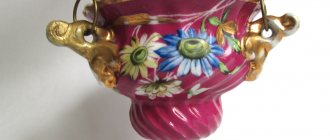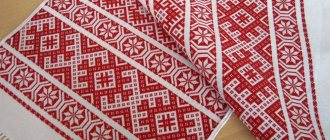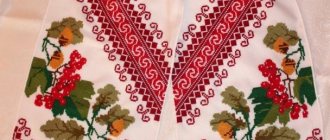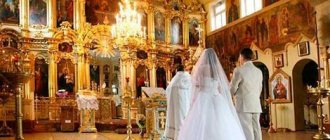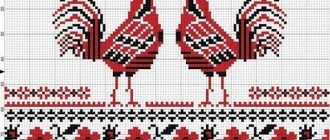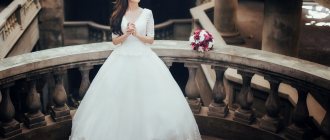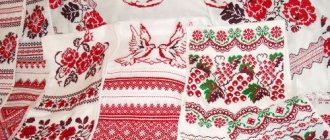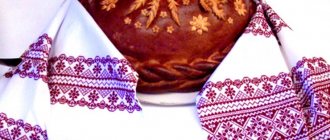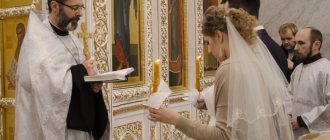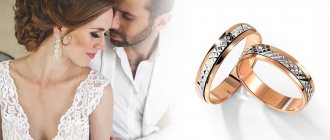A wedding towel is a fabric cloth decorated with patterns on which newlyweds stand at a wedding in an Orthodox church or a wedding in a registry office. Those who want to follow the tradition are wondering where to get a towel for a wedding.
Of course, you can buy ready-made wedding attributes. Towels are sold in specialized stores, various online platforms, as well as in church shops. In addition, you can order a towel from some needlewoman. However, it is much more interesting to embroider with your own hands - this is exactly what brides in Rus' have done since time immemorial. We'll tell you how to embroider a wedding towel and what rules must be followed.
How to embroider a wedding towel - follow the rules
There are many options for patterns on a towel. The design is chosen based on the imagination and taste of the embroiderer, but there are certain rules that are the same for all towels.
Samples of drawings for towels can be found in books, magazines, and on specialized websites.
The wedding towel is divided into two parts - male and female . All patterns and images are embroidered together. Trees, pigeons, swallows and other birds are often found on the towel.
The embroidery has three rows . The first one is filled with symbolic images, the second one contains wishes for the young family, and the third one contains wishes for the beregins. A wreath is embroidered in the center of the towel, in which the initials (capital letters of the name) of the man and woman entering into marriage are placed.
Family tree on a wedding towel
First of all, the border is embroidered, and then the family tree and other images: birds, animals, trees. The tree of the genus is usually the most inconspicuous in the entire towel. However, it is also the most symbolic .
The genus tree grows from a pot and has two nodes: parent and child. The first branches are the grandparents. The mother's parents are depicted on the right, and the father's on the left. If the branches are directed downwards, it means that the relative is no longer alive; if they are directed upwards, they are alive.
On the central node, uncles and aunts are represented by dots, and on the second level, the parents of the bride or groom. Brothers and sisters are embroidered on the top knot. All women are defined by a triangle, all men by a square.
wishes for the bride and groom are embroidered next to it . It is appropriate here to embroider text from the Bible or symbolic images. For example:
- lilies are a symbol of purity;
- roses - beauty;
- carnations - fidelity;
- poppy – fertility;
- grapes - wealth;
- oak – durability and strength;
- viburnum - continuity of family ties.
For the initials of the bride and groom, choose any font of your choice. The embroidered towel is rolled up and stored throughout the entire life together.
How to embroider a wedding towel with a cross?
Embroidered wedding towel
There are a variety of free patterns for cross stitch, among which you can find an option for a towel. The option is easily selected among those available on the Internet. In addition, kits are sold that contain a pattern for embroidering a towel for a wedding loaf or wedding, thread, needle and canvas.
Schemes can be combined with each other
There are schemes of varying complexity, including a certain number of colors. The embroiderer, at her discretion, can choose part of the design from one pattern, and, for example, an ornament from another.
The ornament of towel cross stitch patterns on an icon or wedding can also be symbolic. For example, according to the ornament, you can embroider flowers symbolizing some wish for the young. There are also patterns of diamond patterns, in the form of birds or patterns .
Towel for wedding cross
Previously, a home-woven towel with birch, viburnum, oak trees or other embroidered images was used. Nowadays, for cross stitch, it is most convenient to buy Aida 14 canvas. The edges of the canvas are hemmed by hand. The white field that remains after embroidery is removed. The length of the towel should be at least 140 cm plus the border, and the width 45-50 cm.
When cross stitching, great importance is given to the reverse side. They say that the front side is for people and the back side is for God. To get a perfect back, no knots are used . The thread is secured with a loop.
Basic rules for an embroiderer
It is considered important to observe the following features of a towel depending on its purpose:
- Motives. Here it is worth understanding the symbolism of your area so as not to get confused.
- Towel sizes. If it is enough to wrap the icons with a small piece of linen, then when marrying, the newlyweds should place both feet on the white part of the towel.
- Proportions of embroidery and pure fabric.
Most importantly, when creating, you cannot sew a towel from several pieces of fabric. Only whole cloth is used.
In theory, the cut size should be a multiple of 7. There is an opinion that the length of the towel is a multiple of the embroiderer’s height. Although the first assumption is much more common.
Weaving factories for sale produce towels approximately 2 meters long and 50 cm wide (approximately, apparently, the multiplicity is maintained).
When embroidering a wedding towel under the feet, it is important that the newlyweds fit completely on the fabric.
Embroidery takes up a quarter of each half along the edges. The second option is when only a third of the canvas in the middle remains white, the rest is filled with ornaments.
Pay close attention to the beautiful reverse side. Double-sided embroidery or neat parallel stitches should be done.
On a note. If you are creating a towel from scratch, do not forget to trim the edge of the fabric. To do this, make a hem in 1-2 folds and tack it through a cross. On the front side you get a dotted line of stitches.
The classic technique is cross stitch, but modern needlewomen resort to satin stitch and tambour embroidery. Some people use hemstitching. Although historically it is believed that you cannot make patterns with holes: family life will become just as full of holes.
On a note. In general, there is a whole list of rules for embroidering towels. For example, start on Thursday, you can’t do needlework at night, and you can’t do laundry. And a whole list of similar conditions. That is, needlewomen made a ritual object that carried divine power and protection from negativity.
The color scheme is a classic red ornament, black and red, with green veins. Sometimes blue threads were used. If you understand thoroughly, then you combine symbolism in the image and color scheme.
Embroidery of a wedding towel with beads
Towels embroidered with beads look very beautiful. For independent work, you will need to purchase fabric, a needle, a set of beads of the desired color, threads and other accessories.
You can find ready-made kits so you don’t have to buy the items you need yourself.
The pattern will look neat if all the beads have the same diameter . The highest quality in this regard is Czech or Japanese beads.
Most often, ceramic or glass beads . It is better to buy ceramic, as it does not lose color when washed or rubbed. The same cannot be said about glass beads.
Towel for wedding with beads
To embroider a wedding towel you will need silk or cotton threads . They are good because they do not stretch and have increased density. Polyester threads and those impregnated with wax are also suitable. The color of the thread is matched to the shade of the fabric or beads. The needle used is thin, with a small eye (No. 12).
Patterns for embroidery with satin stitch
The most necessary tool, as all lovers of cross stitch know, is a needle with a blunt end and a sharp one. In order to embroider with a cross, you will need a needle with a blunt tip; a sharp needle is useful for the second type of embroidery.
You need to stock up on silk fabrics, for them small sharp needles No. 1 or 3, for medium fabric - needles No. 4 or 8, if the fabric is thick - No. 9 or 12.
An equally important material for needlework; floss, which is most often used, is useful for satin stitch embroidery.
Floss will be convenient for those women who have spent a lot of time doing cross stitch.
If you have no experience in this action, then in a specialized store you should buy the optimal colors from well-known sets, for example, “Gamma”.
It is not advisable to buy very expensive materials, the same applies to threads: the result of the work does not depend on the quality of the tools.
At the beginning of getting acquainted with creativity, it is worth stocking up on profitable things, then the result, to some extent, will depend on the quality of the materials purchased. Embroidery, like any type of creativity, requires first of all mastery of technique.
The choice of fabric is also important - you should give preference to the one that does not stretch: ideal for beginners, it is not so scary to make a mistake - cotton, linen.
To create drawings, you will need a hoop that requires strong tension. Cross stitch does not require attention to tension; if desired, the fabric can be placed directly on one’s lap and done, but satin stitch embroidery does not require the fabric to sag.
There are many different ideas for creating the desired drawing, it all depends on your imagination, desire, and inspiration.
The main thing is to show all your creative abilities and give them new life! Beginners are advised not to draw very small objects, a lot of details or too large: so as not to suffer later until the painting is completed.
To transfer a design onto fabric, you need to choose the following options:
- Using a carbon copy. The most popular method, known in ancient times. There is black copy paper, white, colored, the color will depend on the color of the fabric.
- On the window. The design is fixed on the window glass with tape, fabric is placed on top and outlined.
- Marker and iron. The drawing is traced onto tracing paper with a marker, then it is transferred to the fabric and ironed.
How to embroider a towel for a wedding using satin stitch?
Most often, the towel was embroidered using satin stitch. This had a certain symbolism - it was believed that the life of the newlyweds would be as smooth as the stitches on the wedding towel.
Satin embroidery is the most ancient technique
Another name for this technique is damask embroidery. Patterns for embroidering wedding towels in satin stitch involve the use of various seams. The entwined standard seams look especially beautiful.
Covered seams with satin stitch for towel embroidery
Stem stitch - Stitches partially overlap each other, resembling a lace. In this way, stems or individual lines are embroidered, and the contours of patterns are trimmed. The seam is made from bottom to top or from left to right.
Loop stitch - performed from left to right, with the needle moving from above. The thread is brought out on the front side at the bottom point, after which a stitch is made with a needle in the top-down direction. In this case, the thread remains under the needle, and the working thread is tightened until a loop is formed. This stitch is convenient for embroidering small design elements: leaves, small flowers, etc.
A narrow satin roll is performed in two stages. First, the line of the satin roll is outlined using a “forward needle” seam. Then, small and frequent stitches of the same length are made in one direction (vertically or at an angle). The stitch is used for embroidering fine lines of the design and finishing the edges.
Chain stitch embroidery involves blind one-sided loops coming out of one another. On the front side, the seam resembles a crocheted chain. In this way, straight and curved contours are embroidered.
Towel for wedding satin stitch
The satin stitch is used to fill large areas of the pattern. These are long or short cross stitches across fabric. First, the area is filled with long stitches, and then short ones are placed across them.
Satin stitch with flooring - stitches are made on a pre-embroidered flooring, which is made with thick threads. The embroidery then looks voluminous.
Bias stitch is used to make patterns with a wavy line of contours. The stitches fit tightly together and are embroidered exactly along the contour.
Flat stitch is a double-sided embroidery method. The technique is used for embroidering floral ornaments and elements on towels. All stitches fit tightly together on both sides.
Element of embroidered towel with shadow satin stitch
The shadow stitch is made along a loose stitch using threads of various shades. There is no clear boundary between colors. The transition is achieved by using stitches of different lengths that fit into each other.
Why beads and not threads
If in the past people really embroidered most often with threads, today beads are the top choice. This is no coincidence, because the use of these small beads makes the product more festive and solemn. Even if the traditional colors red and black are taken, they are much brighter and more saturated.
Beads are also attractive for the following:
- creating a volumetric effect. For towels, the technique of partial sewing is used, so the place where there are beads rises above the rest of the fabric. This helps to achieve an original three-dimensional effect;
- ease of operation. Only at first glance, the bead embroidery technique is complex. In fact, with the right materials on hand, the right needle and a pattern that suits your skill level, you can create a true masterpiece;
- originality of the finished product. Today people rarely embroider with their own hands, and even using beads. Therefore, such a towel will become a real family heirloom.
To create such a product, you need a diagram. For canvases with beads, it is applied directly to the canvas. This greatly simplifies the task of the needlewoman. You can view and select the original scheme here: https://igolochka.com.ua/catalog/rushnyki-na-ikony.
Crocheting patterns for towels
Crochet lace for a towel is used as a border. The pattern is usually knitted separately and then sewn to the finished embroidered towel. Crochet patterns can be found in specialized magazines or on the Internet.
How to knit a pattern for a towel, watch the video.
Using a towel for weddings is an old tradition that dates back to ancient times. In the future, the towel is kept by the husband and wife throughout their life together. It cannot be re-gifted or used in everyday life.
Selecting a canvas
Canvas is our basis for embroidery. It is made from different materials - linen, cotton, hemp fabric, acrylic, wool and even plastic. We advise you to select a canvas from a material that is ideal for your idea.
- Hemp fabric is most often chosen for its durability. You don't even have to use a hoop to embroider on it. This fabric is very dense and retains its shape for a very long time.
- Plastic is a new hit among craftswomen. This canvas can turn your product into anything, as it easily changes shape. Just cut out the shape you need and the base is ready. Children especially enjoy embroidering on plastic, it's so easy and fun.
- For those who want to add volume and texture to their embroidery, we recommend using wool canvas . But no matter how beautiful the finished product looks on such a basis, it is still not very convenient to embroider on wool due to the numerous fluffy threads sticking out.
- Cotton is a true classic in the art of embroidery. And all because this material is very even and smooth. Embroidering with this material is a pleasure.
- Is it difficult to work with wool, but still want a little volume? Then choose acrylic . Despite its non-natural origin, it is much easier to embroider on it than on wool, and it is also less fluffy.
- Linen is also popular among craftswomen. But if you decide to decorate any item of clothing with a beautiful ornament, then it is better to check how such fabric behaves by first washing it.
Canvas for embroidery in the catalog
Aida cotton canvas . This brand is famous for its versatility. Everyone can choose a material with the desired cell size. This canvas is used by both beginners and already skilled embroiderers.
Aida canvas is divided into cells, which greatly simplifies the process of cross stitching.
Another equally popular canvas is produced by the brand Hardanger . Do you want to embroider using tapestry or satin stitch techniques? This material is the best base. But, unfortunately, it will not suit you as beginners. If this is your first time picking up a needle and thread, it is better to start with canvas No. 8. It is actively used for teaching embroidery.
